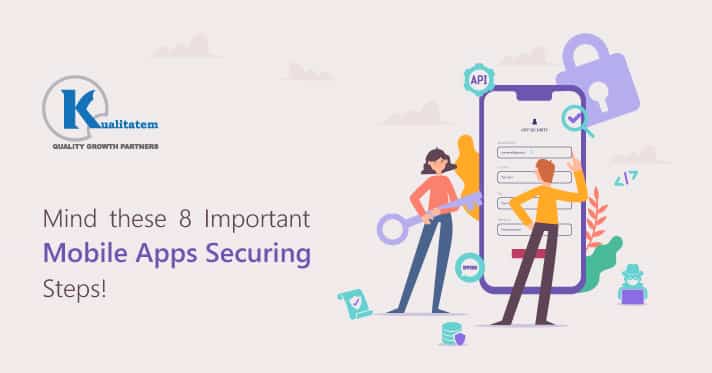Mind these 8 Important Mobile Apps Securing Steps!

- December 12, 2018
- HibaSulaiman
Mobile apps are everywhere. Whether for watching news 24/7, listening to music, playing games, booking hotels, purchasing a product, or even for money transfers.
As satisfying as that sounds, mobile applications are the subject of attack vectors. The not-at-all-friendly hackers wait for their golden ticket to stealing valuable user information, which includes credit card, social security numbers, and bank details. They steal data, duplicate stuff, and even take full control of your personal assets including money.
So, it is significant to ensure that the mobile apps you use, either for personal or corporate daily activities, are fully secure.
If you need to ensure that your mobile applications are secure and fool-proof from attackers and vulnerabilities, follow these 8 steps and be a winner:
1. Secure the source code
Most of the hacker attack a mobile app during its development stage since the security measures have not been put in place by then. The possibility of the app being exposed to vulnerabilities is higher at the development stage.
This is what you can do to secure it make sure that you have protected the application with encryption. You can carefully scan the source code for any kind of vulnerabilities. Your application code should be easy-to-update, rebuild, and can easily be ported between different devices and OS versions. Be conscious of the app’s file size, run time, its memory, data storage, and battery status. You shouldn’t compromise on the performance of the app in trying to secure it.
Don’t completely trust on app store’s approval, since it can’t be 100% accurate.
2. Take security measures for data protection and deny unauthorized access
Authenticate Application Programming Interface (API) in order to stop the transfer of any kind of personal or business-critical data in the wrong hands. Create encrypted folders or containers to keep your data out of harm’s way.
Also, note that data encryption and encrypted connections in VPNs are safer and cannot be breached easily.
3. Identify, Validate, and then Authorize
You can add an extra layer to API through authentication and authorization. You need to make sure that the APIs used within the app provide access only to the most central parts of your application.
OAuth2 is a new framework that helps in creating strong security connections. By installing this in the server and modifying it according to the requirements of the app. This will allow users permissions to gather and secure credentials between client and users.
4. Set up a good mobile encryption policy
You need to establish a fully secure mobile encryption policy. Prefer to use file-level encryption. Align the application codes since the passwords and data cannot be saved directly onto the device. If they need to be stored, double check that they have been encrypted.
5. Align a robust API security strategy
Keeping your API secure is very important. Make sure that you follow all the security measures for a robust API security plan which include identifications, authentication, and authorization.
6. Test once, test twice, and test again!
Never get tired of testing. Because if you do, you might lose sight of loopholes or defects that might pave a path for hackers to hit your territory. It is a common practice of a mobile application testing company to make sure that they test the application thoroughly and double check for any the data security problems or vulnerabilities.
Penetration testing is also helpful in identifying weak posts within the system’s infrastructure. You can take help from emulators or real devices to understand the performance of an app running on any device or OS in a controlled environment.
7. Alert your Users
You cannot entirely depend on developers and testers to protect your app from hackers. Your users should be aware of any essential security pointers to help them use the app securely. Also, inform the users to download apps only from authorized websites or play stores.
8. Set up more secure strategies for a BYOD policy
There are several companies in the market that allow employees to bring their own devices at a workplace. There are chances that you will experience more security threats within this open network system.
One way to protect your system from getting attacked is by using VPN for a more secure work environment. You should ensure that the devices are protected with up-to-date anti-viruses and have firewalls and an anti-spam system active and working.
Another safe way is to get those devices checked by the IT team or allow only authorized devices to be brought to work, especially in case of rooted and jailbroken devices.
Conclusion
Follow these 8 steps diligently, your mobile app can be secured in general. Moreover, you can also hire a professional mobile application testing company that renders continuous monitoring and timely testing to ensure that your app is 100% secure.











